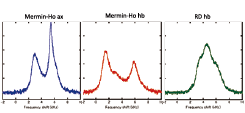Vortices of Superfluid 3He in a Narrow Cylinder
O. Ishikawa and T. Kunimatsu
Vortices are well known fluid phenomena, whose size is widely distributed from the scale of a galaxy to that of water vortices in a laundry machine. The vortices familiar to us are classical ones with circulating motion of fluid, which are well described by a classical fluid mechanics. In modern physics, other types of vortices are found in liquid 3He and 4He from a quantum mechanical point of view. Both of quantizing a circulation and having a localized vorticity characterize a vortex in superfluid. Especially superfluid 3He having many degrees of freedom in a condensate is more interesting than superfluid 4He having only one type of vortex.

Fig. 1. Three types cw-NMR spectra in superfluid 3He-A phase confined in a single narrow cylinder of 50 μm radius. Each spectrum corresponds to a different texture (spatial structure) of order parameters in the condensate.

Fig. 2. Stable textures on cooling under rotation at two kinds of magnetic fields. (a) RD hb texture appeared at 21.6 mT. (b) MH hb texture appeared at 21.6 mT after passing through Tc under 0 mT.
You can rotate normal liquid in a bucket by rotating the bucket itself but in the case of superfluid it is not easy to rotate it in such a way. Besides a vortex nucleation problem, stabilizing vortices in the bucket is another problem when the radius of bucket becomes very small, so-called a confined geometry. The necessary angular velocity of rotation to stabilize a vortex depends on the radius of cylinder and the quantity of circulation quantum of vortex. In superfluid 3He-A phase, several types of vortex in bulk liquid have been observed but it was not clear whether another type vortex appears in the thin cylinder, where the angular velocity stabilizing a vortex becomes large. We showed that circulating velocity fields in superfluid 3He–A phase were created in a very narrow cylinder, 100 μm in radius, using the rotating cryostat in ISSP, where three types of vortices were observed [1]. Two of three have the circulation quantum of unity and another had that of two, which was the same vortex as that in bulk liquid. Recently we can manipulate the type of vortex in even narrower cylinder, 50 μm in radius, in which three types of vortices are observed and all vortices correspond to the circulation quantum of unity [2]. A different type of vortex consists of different structures of order parameters of the condensate in a cylinder.
Figure 1 shows that three typical cw-NMR spectra in a single cylinder of 50 μm radius. A spectrum consists of a few spin wave resonances. Spin wave resonances are the low energy excitations in magnetic resonance experiments, whose frequencies are determined by NMR potential created by the dipole-dipole interaction ED between 3He nuclei in superfluid state. The order parameters in spin space and in orbital space are coupled each other through ED. Three NMR spectra correspond to three types of textures, which are the spatial structures of order parameters in a cylinder. Our analysis reveals that they are Mermin-Ho hb texture, Mermin-Ho ax texture, and Radial-disgyration (RD) hb texture (see details in ref. [2]). These textures correspond to three types of vortices that can be observed in a narrow cylinder.
We have always observed one of three NMR spectra and have not observed the spectrum where the textures coexist each other. Figure 2 shows the stability of textures in the rotation-temperature phase diagram strongly depends on the magnetic field on cooling through TC (transition temperature between superfluid and normal fluid) under rotation. The experimental procedure is quite similar to that of field cooling technique in studies of superconducting material. Theoretical calculations have been done about the stability of texture under rotation in magnetic field [3]. There exist qualitative and quantitative discrepancies between calculated results and observed ones on the stability of the texture in varying temperatures, magnetic fields and rotation angular velocities. We think that these discrepancies are attributed to the metastable state of texture because the textural transition needs a higher energy state between textures.
References
- [1] R. Ishiguro, O. Ishikawa, M. Yamashita, Y. Sasaki, K. Fukuda, M. Kubota, H. Ishimoto, R.E.Packard, T. Takagi, T. Ohmi, and M. Mizusaki, Phys. Rev. Lett. 93, 125301 (2004).
- [2] T. Kunimatsu, H. Nema, R. Ishiguro, M. Kubota, T. Takagi, Y. Sasaki, and O. Ishikawa, Phys. Rev. B 90, 214525 (2014).
- [3] Y. Tsutsumi and K. Machida, J. Phys. Soc. Jpn. 78, 114606 (2009).
